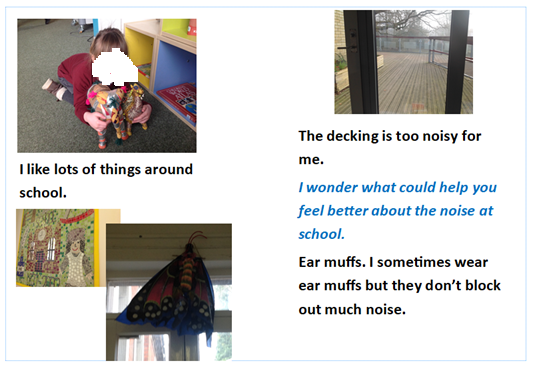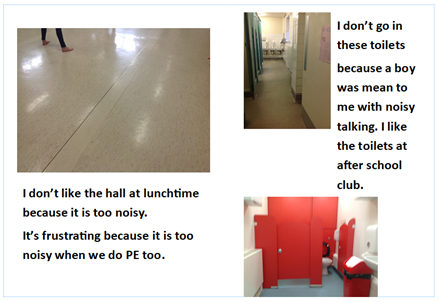
Hassocks Infant School was nominated by the Autism and Social Communication Team (ASCT) following participation in the Autism in Schools Project. Working with the Hassocks Infants Team, the ASCT were impressed with the work they have done to ensure they gain their pupils’ voices despite their young age. The schools uses this input to develop a greater understanding of individual pupils, plan support, ensure they meet individual needs and harness individual strengths.
Context
Hassocks Infant School is a mainstream school for children aged 4-7 years, covering Reception to Year 2. The school is a three-form entry school based in the village of Hassocks at the foot of the South Downs with a roll of 270 children.
The school is committed to offering a stimulating and challenging learning environment for the children where they build on pupils’ interests and strengths. Their topics put an emphasis on creativity, learning outside and developing the whole child. The Hassocks Infants team are committed to supporting pupils to become willing, independent learners through a trusting partnership between school, families and the wider Hassocks village Community.
Good practice explained
Here, SENCO Sara Nash explains how her school have developed their pupil voice and how they use feedback and information from their young pupils.
We have given the children the freedom to express how they feel about their learning environment by letting them lead their own photo elicitation session. Previously we had been looking at the school experience of our Autistic children from the ‘outside in’. The pupil voice that we have collected has enlightened us to issues that were not apparent during our observations alone.
We begin the sessions by explaining to the pupil the reason why we are undertaking the exercise and that we will make a book of their photos and words once we are finished. We also explain that it is ok if they just want to take photos and do not wish to talk. This way we can capture information, feelings and memories in a verbal and/or non-verbal way.
A well-known adult accompanies the child as they take photos of their choice and also to note their comments. This can be any number of photos and has varied from a few to over one hundred! One pupil commented “I have to take six pictures of everything because I am six!”
As we move around the school the adult records pupil voice without leading the conversation or diverting the child from their thought pattern. We have found that children express memories of having had difficulties in the past. A Year 1 child remembered playing on an area of decking in reception and commented “The decking is too noisy for me!” despite not having played there for over a year.

We upload the photos and make them into a booklet with the accompanying pupil voice, if we have any. The adult ‘reads’ the book with the child to see if they agree with what has been written or if they would like to add anything further. Once the book is printed, a copy is given to the child to look at with their teacher; special time is set aside for this. A teacher commented, “I did not realise that she had any of these sensory needs, we did not mark them as being an issue on our checklist and neither did the parents”.
Another copy is given to the child to take home and parents are asked to spend time looking at this with their child.

When we reached the hall, this pupil could not bear to take a picture of anything other than the hall floor because it was too noisy.
Another child commented; “I don’t like it, it’s too noisy. It’s so noisy I feel like I can’t look at it. The kids are quite noisy in our school. I don’t feel very nice at all when I look at it. I feel like that. I feel like that a lot, every day in Year 1” (talking about the school hall where he has lunch).
We ensure that the child knows that we will do our best to act upon what they have shown or told us. If the teacher changes something in reaction to a photo elicitation session, they ensure that the pupil knows it is because they have been listened to and that we have taken action. A parent commented; “Thank you so much for the copy of her pupil voice story, it’s amazing! Very revealing as you say. I asked her last night what we could do about the noise issue and we talked about the option of noise cancellation headphones.” Also, a pupil has been referred to Occupational Therapy due to the sensory needs that they were able to express during this exercise.

We also schedule to repeat the photo elicitation exercise with the same children the following term to see if any of the measures we have put into place have made a difference to the children’s lived experiences.
The children always enjoy the process and overall, we have found that the children talk honestly about how they perceive school. This has strengthened our belief in the competency of young Autistic children to meaningfully contribute to their school life.
Top Tips from Hassocks Infant School for other schools:
- Let photo elicitation be completely child led.
- Record everything in their own words.
- Let the pupil share their book with staff and family.
- Use photo elicitation booklets as part of referrals, reports, transition notes, ISPs, EHCP annual reviews etc.
Links to the West Sussex Inclusion Framework
We can see a clear link to a key dimensions of the Inclusion Framework:
4.4 Meeting needs of individuals
- The school shows evidence of preparing for the inclusion of a wide range of individual children and young people (CYP).
- CYP who are experiencing barriers to learning and participation are viewed as individuals with different interests, knowledge and skills.
- The school outlines the arrangements for and identifies and assesses CYP in order to provide additional and different provision to meet individual needs.
Specifically:
- CYP and their families are consistently and effectively involved in every stage of the ‘assess ‘plan, do, review’ cycle (graduated approach) and understand why an intervention is being used, how the curriculum has been adapted, and the impact this has made. For CYP with an Education, Health and Care Plan (EHCP), this is also captured as part of the Annual Review cycle.
- Regular reviews with CYP with special education needs and disabilities (SEND), additional needs and those at risk of disadvantage show they are really being listened to and acted upon, their needs are being met and significant progress is being made. The setting obtains information to support this directly from the parent and CYP on their strengths, interests, needs and emotional well-being.
- Individual provision maps, or similar alternatives, have been developed in consultation with CYP and parents and clearly identify a wide range of strategies to support independent learning. These plans have a sharp focus on evaluating the impact of provision and support.
 Tools for Schools
Tools for Schools